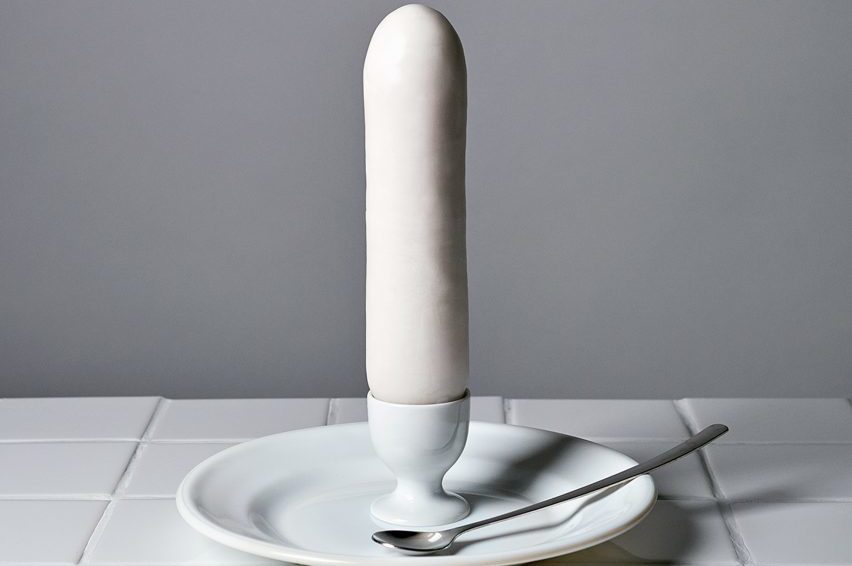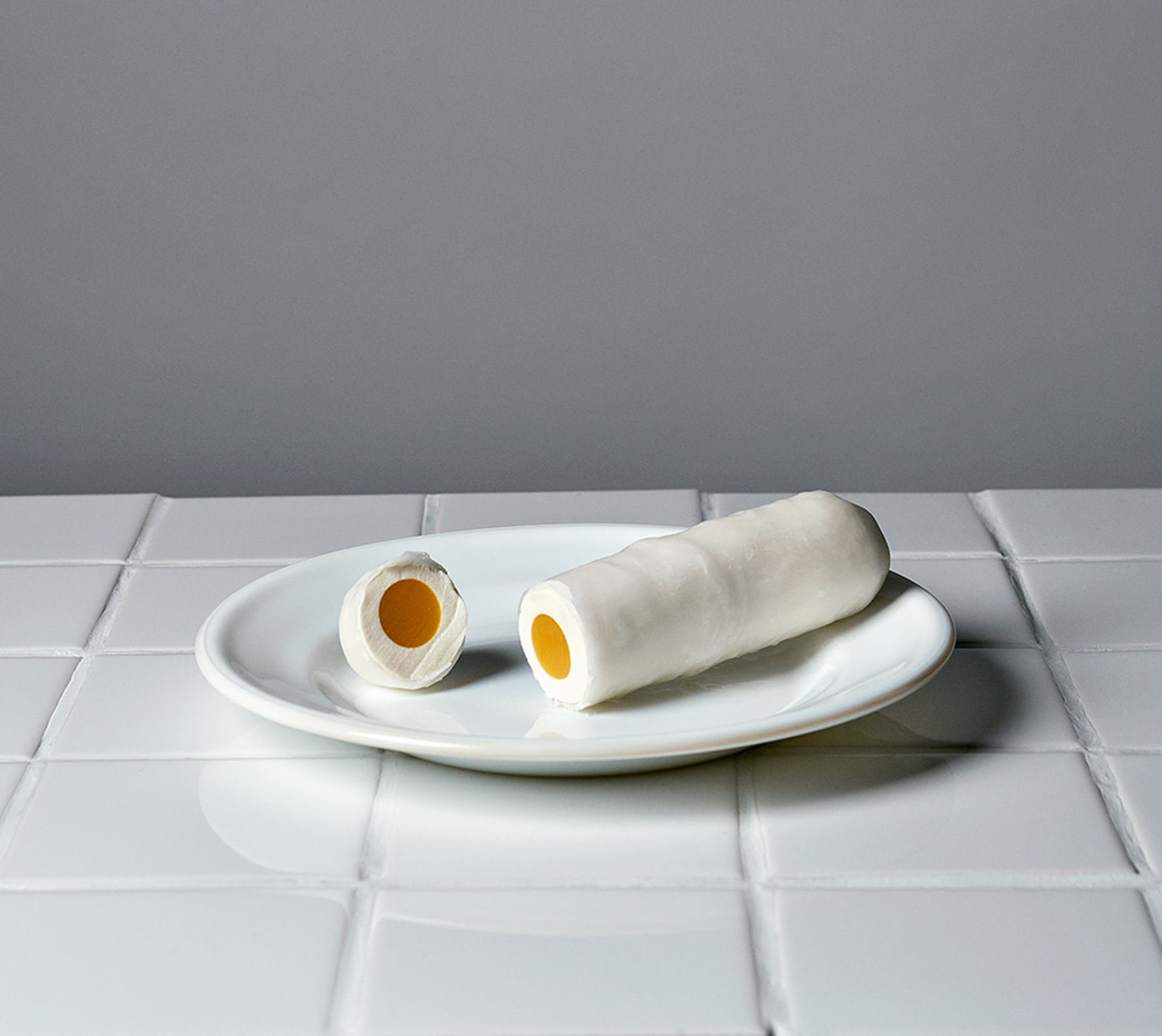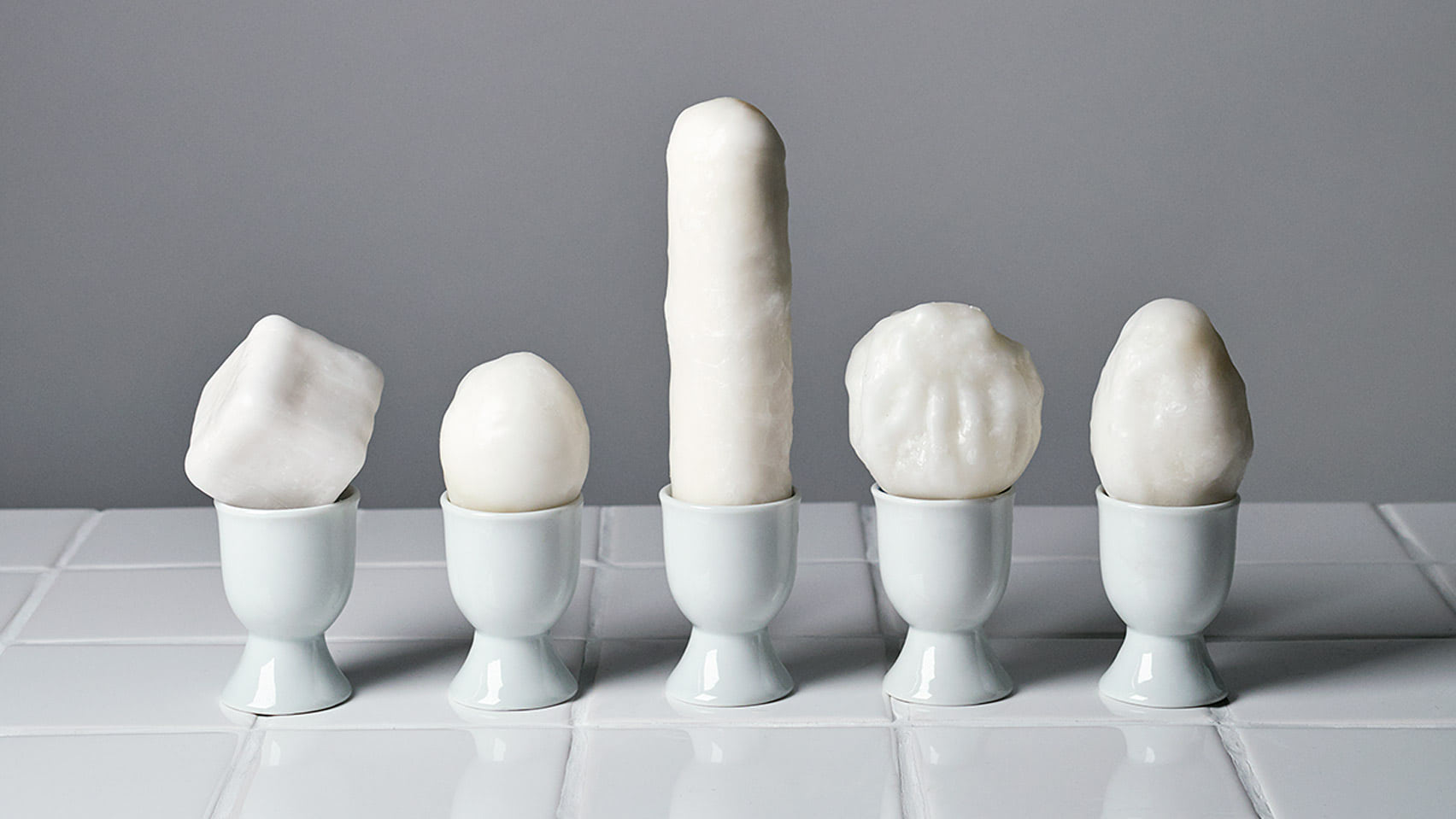This story is part of Next Generation, a series in which we give young makers a platform to showcase their work. Your work here? Get in touch and plot your coordinates as we navigate our future together.
For her MA Material Futures graduate project, designer Annie Larkins set herself the impossible challenge of reverse engineering the humble chicken egg from scratch... That is, without a chicken.
The project started as a response to concern for the environment, an interest in vegan alternatives and sustainable food production, as well as a genuine appreciation for the complexity and dynamism of eggs; their form, nutritional value and symbolic existence across a range of cultures. An Egg Without A Chicken draws on an often overlooked history of unnatural processes that have shaped how ‘real’ eggs exist today, and forms a playful challenge to our current understandings of what is natural, or sustainable.
"This project is a celebration of the egg"
Why make an egg?
Larkins identifies the intrinsic value of eggs as a versatile, nutritional and widely eaten food source: “eggs are a biological masterpiece; eaten across every culture and have been seen since prehistory.” Moreover, she recognizes how eggs intersect with human culture in multiple ways: “eggs are highly symbolic, associated with religion and folklore, life, creation, fertility, beauty, health, purity, mystery and nature to name a few.”
"Eggs are so commonplace that we overlook this everyday masterpiece."
However, in the context of our current food culture, eggs do not wield this kind of symbolic power or appreciation. Larkins highlights how “meat, eggs and dairy are so ubiquitous that they are no longer respected as they should be [...] eggs are so commonplace that we overlook this everyday masterpiece. By attempting to recreate them, perhaps the value we place on the original will be reconsidered.” What emerged from the project was a range of curiously shaped plant-based eggs that tell an important story.
Looking back to go forward
Larkins' humorous faux egg creations are inspired by a more serious history of human design when it comes to seemingly ‘natural’ chickens and their eggs. Her research charts developments such as the first dispersal of chickens away from their origins through trade, the ‘hen craze’ of the nineteenth century, which saw an unprecedented acceleration in selective breeding, through to the use of incubators and battery cages that mark present-day exploitative industrial farming methods.
The designer’s research process also sheds light on how the taken-for-granted process of a chicken laying one egg per day is far from natural - laying habits have been manipulated by humans through selective breeding and the use of artificial light. Larkins recognizes how historical stages of human intervention have gradually “transformed the egg laying hen from an animal to an egg making machine.” Furthermore, she emphasizes how “the contradiction between natural and unnatural in the chicken egg epitomizes the wider problem with industrial production of food.”
“The contradiction between natural and unnatural in the chicken egg epitomizes the wider problem with industrial production of food.”
The project asks, can we break the cycle of human exploitation by reconnecting with our food, by trying something new in order to confront the animal and environmental impact of current practices? For Larkins, “it is clear that our current system of industrial farming is unsustainable. We will continue to need protein as part of a healthy, balanced diet so alternative forms of protein need to be explored [...] The reality is we need a variety of approaches against our broken food system.”

What makes an egg an egg?
When researching current vegan replacements for eggs, such as ‘egg-white’ powder and developments in lab-grown substitutes, Larkins was left unsatisfied - “I felt that many [existing] egg alternatives missed the essence of what an egg is.” It became essential for her to create an egg that would look, taste, behave and be of the same nutritional value as a ‘natural’ egg. After tireless experimentation, and the use of the molecular gastronomy technique of spherification, Larkins’ final ‘eggs’ were made using pea protein, salt, food coloring and algae-derived acid, before being dipped into Candelila wax to create a cracking shell.
With the unnaturalness of eggs forming the starting point of her project, Larkins pushed the boundaries imitation and familiarity by creating three impossible eggs: a long egg, a multi-yolk egg and a square egg. These exaggerated eggs are a playfully absurd speculation on what eggs might look like when no longer subject to the biological constraints of a chicken.
They also play on the fact that eggs have always been shaped by human needs, and consider, how might these needs translate in future adaptations of the egg? Like real eggs, Larkins’ impossible eggs are also influenced by human desire; the multi-yolk and long egg satisfies our need for more, whilst the square egg could result in more economic and efficient packaging. All ask us to question, how different are Larkins' egg replacements from the 'natural' eggs we encounter everyday? How do we define what is unnatural? Where do we draw the line, and who decides?

The future of eggs?
Is this project an operational plant-based alternative to eggs? In sum, no. Rather than boasting the perfect egg replacement, Larkins claims her project succeeded in creating "a range of edible objects that vaguely resemble an egg.” She states truthfully, “my egg tastes worse, is less nutritious, has an appearance nowhere near as satisfying, is less versatile, and has an incalculable environmental impact of its own that is almost certainly larger than a chicken egg.” But should this matter? After all, creating the perfect egg substitute was not the point of the project - from the beginning Larkins acknowledged it was an “impossible task.”
"Future food explorations need not always be working prototypes but can exist as valuable thought experiments."
Rather than evaluating the project in terms of its success as a plant-based alternative, we should consider it an impactful narrative that reconnects us with the uniqueness and complexity of this normalized food source, and consider the outcomes as tangible guides for difficult conversations regarding the hidden exploitation and contradictions inherent in chicken egg production. At the same time, the project is light hearted; it employs humor and absurdity to help us reassess our present. Larkins celebrates the fact her project will not be widely consumed: “the egg will not be tasted by most who encounter the project, which again helps to position it as an object of discussion.”
So, what to take away from this project? Importantly, that future food explorations need not always be perfect replacements but can exist as valuable thought experiments. An Egg Without a Chicken fosters a newfound respect for the biological complexity of ‘natural’ eggs, as both shaped by human desire but at the same time impossible to recreate (yet). For sure, Larkins did not end up with an egg, but rather a set of storytelling egg-ish objects that reflect the past as well as a hopeful future for eggs - “this project is a celebration of the egg, which is both hugely complex and yet so familiar it is unexceptional. It aims to re-frame the egg as more valuable than its price reflects.”

jlsgmdujqp
Muchas gracias. ?Como puedo iniciar sesion?
Muchas gracias. ?Como puedo iniciar sesion?
Posted on